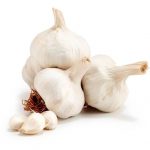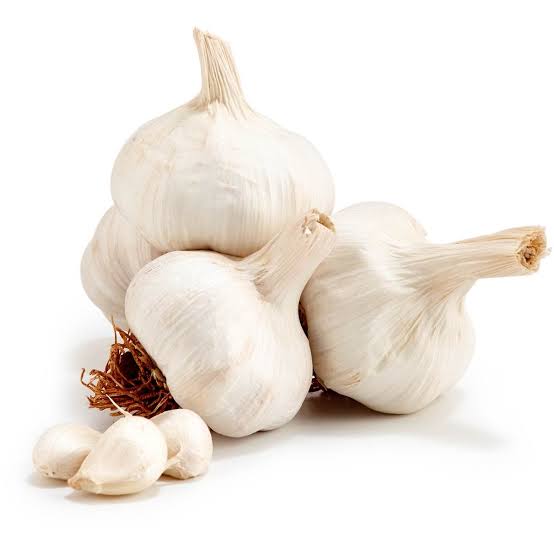Garlic or Czosnek (Polish) or Tafarnuwa (Hausa) or Ayo (Yoruba) or Ayuu (Igbo) can combat both communicable (infectious) diseases and non-communicable chronic diseases (lifestyle diseases)
The physiology and biochemistry of garlic is very difficult and complex, but I did all I could to simplify it for facebook users. I hope all of you will enjoy it!
Garlic is one of the most popular herbal remedies and steadily gaining interest in complementary and alternative medicine practice, which has traditionally played an important dietary as well as medicinal role in different parts of the world.
A member of the Alliaceae family, garlic is one of the more economically important cultivated spices. Large amounts of garlic are produced annually in China and India. About 80% of garlic produced in the USA comes from California. Although considerable consumption occurs as fresh garlic, it is also found as dehydrates, flakes, and salts in a variety of food preparations.
Dozens of garlic supplements are also commercially available as essential oils, garlic-oil macerate, garlic powder, or garlic extract. Czosnek has continued to be one of the top selling herbs in the countries of the European Union and the U.S. Garlic is classified as a spice, herb, or vegetable. Along with onions, leeks, shallots, and chives it is one of the major Allium foods consumed by humans. The garlic bulb consists of several individual pieces, also known as bulblets or cloves, each weighing about 3 g. The characteristic odor of garlic arises from allicin and oil-soluble sulfur compounds formed when the bulb is crushed or damaged. This membrane destruction yields a host of organosulfur degradation products as a result of the release of the enzyme alliinase. This enzyme rapidly converts alliin to form odiferous sulfur containing substances, including allicin.
A lot of experts say that in order for people to harness all the benefits that garlic has to offer, they should not boil it before consuming. Its fresh juice has the highest concentration of nutrients and bioactive compounds, so it is best if it is prepared this way. Heat inactivates the alliinase and therefore inhibits the formation of allicin and other thiosulphinates but some breakdown of the alliin occurs leading to the accumulation of small amounts of other bioactive compounds.
Crushing a garlic clove and putting it in a glass containing hot milk before drinking has also been said to be effective in alleviating symptoms of seizures, cramps and nervous spasms.
Bioactive compounds in garlic possess antimicrobial properties, that is, the ability to kill bacteria, viruses, fungi etc. In fact, historically, garlic and its extracts have been labeled as universal antibiotics. Considerable evidence indicates that garlic extracts can destroy a range of Gram-negative and Gram-positive bacteria and serve as an antifungal agent. Helicobacter pylori colonization of the gastric mucosa (stomach lining) is increasingly linked with gastritis (inflammation of the stomach lining).
Likewise, emerging evidence connects gastritis with a greater propensity to develop gastric cancer. The incidence of Helicobacter pylori infection among the populations of developing countries, including Nigeria is very high. These bacteria cause stomach ulcer, which when left untreated can lead to the development of stomach cancer. Unfortunately, stomach ulcer and its complications are one of the leading causes of death among young people in developing countries. Studies by many researchers provide rather convincing evidence that garlic extracts can inhibit Helicobacter pylori proliferation (multiplication).
Allium foods, including garlic, are also effective in suppressing (stopping) fungal growth. Allicin has been reported to be protective against and a host of other strains. It is worth mentioning that Candida albicans is the main cause of urinary tract infections in women. Regrettably to say, this type of infection is very difficult to treat. Candida albicans have been shown to be very sensitive to garlic extracts, some to a greater degree than to nystatin, a known effective antibiotic. Ajoene, which is one of the sulfur compound in garlic is also noted for its antimycotic activity – a fungal infection of the skin known commonly as ringworm and medically as tinea corporis, can also be influenced by sulfur compounds found in garlic. Preclinical studies have provided some of the most compelling evidence that garlic and its related sulfur components suppress cancer risk and alter (change) the biological behavior of tumors.
Overall, Czosnek and its associated sulfur components have been found to suppress the incidence of mammary, colon, skin, uterine, esophageal, lung, renal, stomach and liver cancers. Nitrosamines, heterocyclic amines, and polycyclic aromatic hydrocarbons are potential dietary carcinogens (cancer causing substances) that are not normally present in foods but may arise during preservation or cooking, especially when meat is grilled and exposed to direct flame. Considerable evidence points to the ability of garlic to suppress the formation of several of the above mentioned compounds. It is said that “silent waters are deep and dangerous”. High blood pressure is somewhat akin (similar) to such a situation and if left undetected and untreated it results in stroke, heart attack and heart failure.
For those who suffer from high blood pressure, the best way to enjoy the benefits of garlic is to take a clove of it every morning. Preparing oil out of it is also possible. Garlic supplements have also been introduced to the public and they come in various forms including extracts, powders and pills.
The ability of garlic to significantly decrease the risk for development of hypertension as well as for its treatment can be attributed to the presence of active substances known as garlic sulphides and allicin. Allicin is a substance which is said to work in relaxing blood vessels while also reducing any tension and pressure as well as damage affecting blood. It also interferes with the effects of angiotensin I enzyme, which causes increase in blood pressure and negatively affect smoothly contracting muscles. Its ability to increase fibrinolytic activity (breakdown of fibrinogen – substance that causes clotting of blood, thereby blocking the free flow of blood) in a person’s blood is also a huge help in reducing the level of cholesterol and platelet aggregation.
Another reason why garlic works in preventing high blood pressure is that it has the ability to stimulate hydrogen sulphide and nitric oxide synthase production, which produce nitric oxide that causes relaxation of blood vessel.
Apart from its cholesterol lowering properties, people can also benefit from garlic because of its effectiveness in improving a person’s digestion and immune system. Still, everyone is advised to seek the guidance of a healthcare provider prior to taking it since this also thins blood and may interact poorly with certain supplements and medications. Garlic in small amounts applied as a food condiment does not usually pose any important risk, aside for rare specific allergic reactions in hypersensitive people.
Negative consequences are not always an outcome of exaggerated garlic intake, but some individuals may be more susceptible to side effects than others. Although their incidence is low, a spectrum of adverse allergic reactions can occur following contact with garlic. Even though garlic is recognized as a powerful irritant, relatively few reports of allergic contact dermatitis appear in the literature.
Avoidance of direct contact seems the most logical approach for food handlers who are sensitive, but this may be more difficult than anticipated as diallyl disulfide (DADS), an active irritant, penetrates most commercially available gloves.

Credit: Woolworth
Excess garlic intake has also been reported to lead to hemolytic anemia. The severity of the anemia correlates with a reduction in erythrocyte-reduced glutathione (GSH) and plasma vitamin C, so this can be alleviated by increasing the consumption of vitamin C and glutathione, which can be found in large amounts in vegetable of the cabbage family. Ingestion of garlic in large amounts is not recommended for at least 2 weeks before surgery.
Garlic’s anti-platelet factors may interfere with normal blood clotting and may increase bleeding time. Avoid ingesting it in therapeutic amounts during post-surgical care, to allow for proper tissue cicatrisation (wound healing). Garlic should not be used in large amounts in persons with bleeding disorders, such as hemophilic patients. Garlic should not be use medicinally in patients with bleeding ulcers or gastritis, due to potential gastric irritation.
Garlic ought to be used with caution in diabetic patients, because it may lower blood glucose levels. It has been stated that lactating women should not consume garlic in large quantity, as the sulfur containing compounds may pass from the milk to the baby and cause gastrointestinal upset, such as colic and diarrhea, but some studies suggest that garlic ingested by the lactating mother will actually increase feeding time and interest in nursing, presumably by the odor present in milk, by the baby. No studies have reported any adverse effects on the children of lactating mothers.
It should not be ingested in large amounts along with drugs that have anticoagulant activity, such as warfarin, heparin, aspirin or prostacyclin. Avoid using large amounts of it while taking acetaminophen (paracetamol) or other drugs metabolized by the enzyme CYP 450 system, as their metabolism may be reduced.
These are the thoughts of:
Sa’eed Halilu Bawa
Senior Lecturer (Associate Professor) at University of the West Indies, St. Augustine Campus, Trinidad.
Studied Food and Nutrition Sciences, Dietetics at Kaduna Polytechnic, Nigeria; Warsaw University of Life Sciences, Poland.
























